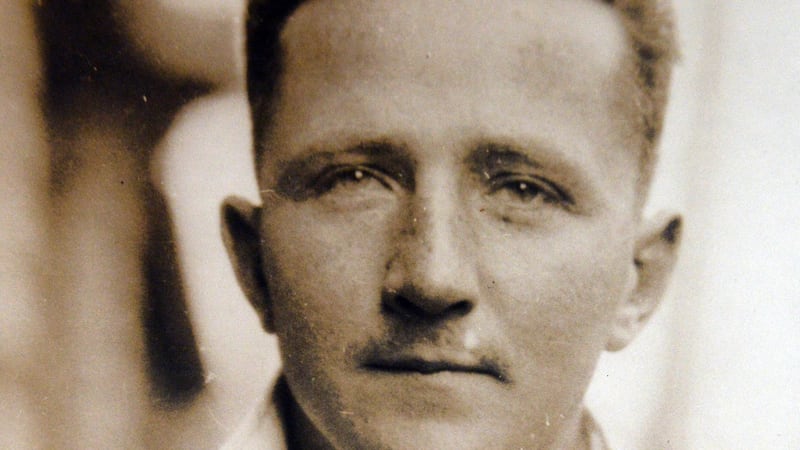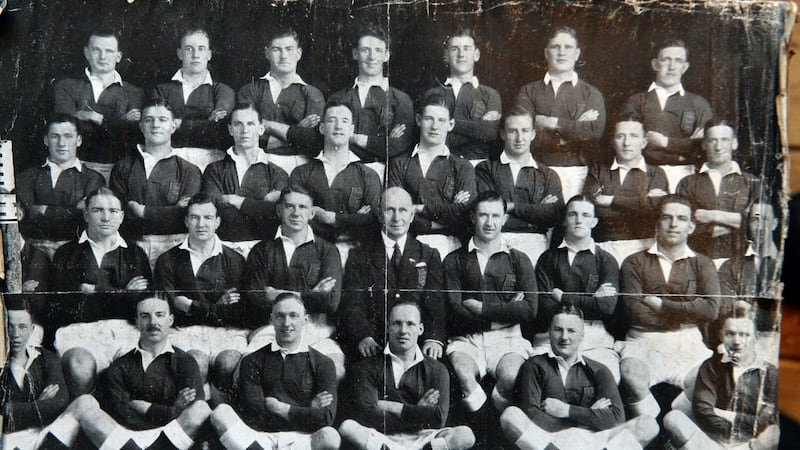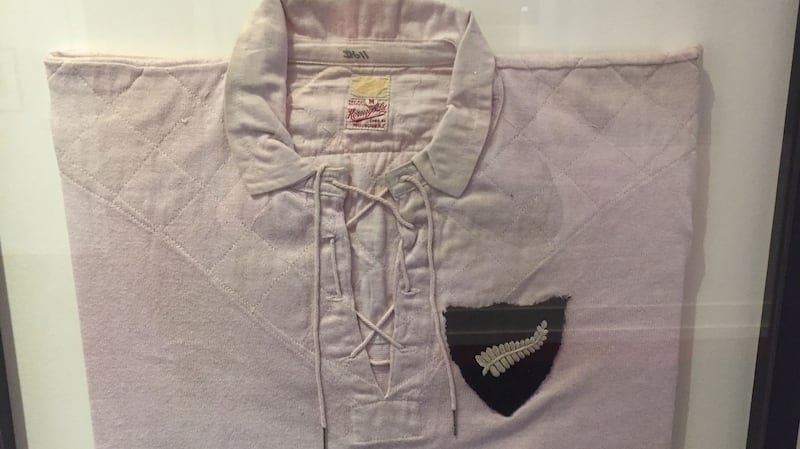All Lions tours are journeys. For Ireland's Michael Dunne, for the British Lions and for the New Zealand rugby team, the 1930 tour was fateful and historic, angry and sweet.
Dunne’s trip was an adventure he began when at 25-years-old he threw in his lot with the Munster and Leinster bank. Rugby for six months on the other side of the world had a ring to it.
The buttoned up bank had told him he could not look forward to his job being there after his escapade. So in April 1930 he took the boat from Dun Laoghaire heading for Southampton.
It was no real shock because when a letter arrived the previous year from London. Dunne had decided this would be his fate.
Dated 18th April 1929, it was a short note from Twickenham secretary SF Cooper headed ‘Tour of a Rugby Union British Team to New Zealand and Australia 1930’ and recommended ‘each player should be in possession of about £50 to £75 for incidental expenses”.
A handsome amount, the sum of £75 in 1930 has been estimated to be £4,372in current value. But the wonder is where any of the Lions got the opportunity to spend their money. In one of his diary entries from May, Dunne describes a day out.
“After lunch private cars drove us to Tom Boothe’s farm 15 miles up country, where he constructed a private nine hole golf course...It was a beautiful afternoon and we all finished by having tea with Mr Boothe and family after which we were driven back to our hotel. Our car happened to be Rolls Royce.”
To that backdrop Dunne struck up a distant and ultimately platonic relationship with a beautiful Maori girl called Rao Ellison that would remain alive for over 80 years and end with the return, three years ago, of the Lions jersey Dunne had worn and sent to her.

He recorded with beguiling innocence the night in June of that year when he first met Rao.
“After dinner we went to a Maori entertainment and I met some charming Maori girls, one a Miss Ellison, whom I liked very much,” he wrote.
Green turnover
The tour would also set in train the recognition of the Irish as a distinct set of players from the British and, after many raised voices, firmly establish the black New Zealand jersey as theirs alone and an iconic national brand.
In a fascinating historical snapshot of the voyage that first set out from Southampton for Panama, Dunne kept pictures of the players having scrum practice on deck, a team of jockeys beside today’s minibus physiques.
There was a relatively new Panama Canal and Sydney Bridge with working cranes and a large gap, where a span or two of the middle section had yet to be completed.
Throughout the tour in newspapers and dinner menus, the team was referred to only as 'The British Lions'. To this anomaly a Cork member of the squad took exception and the Dunmanway-born, Air Marshall Sir George Beamish began a campaign for Irish recognition.

It was Beamish who expressed discord at the fact that the blue of Scotland, white of England and red of Wales were represented in the strip there was no green. A green flash was added to the socks, which from 1938 became a green turnover, a feature of the strip ever since.
But it was the decision the Lions took to wear their navy blue jersey that sparked the more serious wailing among the All Black elite. Because of news reel needs of the time, the teams needed to have contrasting colours for the cameras.
What seemed a simple solution and one employed routinely at the time, the home team would change colour.
"My father kept everything, all the jerseys and he somehow also managed to get an All Blacks white jersey," says Peter Dunne, son of Mick.
“The controversy was quite strong. It was customary for the home team to change strip in order to accommodate the strip of the visiting team but the All Blacks didn’t want to change to white.
“The Lions at that stage wore dark navy, almost black. And the All Blacks at the last minute seemed to have almost cut the fern out of the black jersey and sewn it on to the white jersey.”
Newspaper headlines at the time sketched the nature of the dispute.

“Indignation growing,” said one New Zealand paper. “Some Famous Critics,” said another and “Wairarapa Protest,” added yet another.
Silver fern
Dated Invercargill, March 15th 1930, a Press Association report describes the unhappiness of this sleight on the team after 37 years of wearing all black, a ruse they contended was deliberately engineered by a ‘British’ team eager to reassert rugby dominance over a colonial outpost.
“Local Rugby Union officials, referees, past and present footballers and sportsmen generally are indignant at the decision of the New Zealand Rugby Union that the New Zealand representative team, when it meets the British team, is to play in white jerseys,” said the report.
“One and all were of the opinion it was a courtesy carried too far and that if any team was to be asked to change colours, it is the visitors, who, it is stated, when they chose dark blue, knew quite well that the New Zealanders had worn all black uniforms ever since they began to take so prominent a place in international rugby.”
The silver fern of the white jersey, on display with Mick Dunne’s Lions jersey in Lansdowne RFC, does indeed seem cut and roughly stitched from the black jersey.
It was the Lions’ jersey that was sent on a journey to Rao Ellison after they met in 1930 and ended poignantly in 2014 with her daughter Robyn returning it to its spiritual home in Dublin.
In between there were many letters exchanged.
"You could say it was platonic. Mum and dad are dead 50 years," says Peter Dunne about a tragic event of his life. His father and mother were to pass within two weeks of one another when he was 16-years-old, his older sisters and rugby international Eugene Davy, his godfather and founder of Davy Stockbrokers, stepping up to hold things together.
“The Maoris were most generous to the tourists. That in its own innocence is as innocent as it sounds. But he just met her on that day on June 20th 1930, this girl Ms Ellison.
"One day Eoin Ryan, the senator was at a charity dinner in London and happened to be sitting beside this woman who said to him 'Oh you're Irish do you know the Dunne family?' She explained the connection with Lansdowne."
“Both of them were single at the time at a social occasion after a Lions event. My father was greatly taken with her and she with him.
“I have all her letters to him. I don’t have any of his letters to her. We weren’t aware of this at all but they corresponded because the Lions moved on to Australia for 11 matches. They were in New Zealand for 17 matches and played one in Sri Lanka on the way home. They had 28 matches in total.”
Dear Sir
Distance put paid to another physical reunion between Rao and Michael with his affections remaining with him on his return to Ireland to begin a career in law.
“She wrote to him and the letters began as ‘Dear Sir’ and then ‘Dear Mr Dunne’ and went on to become ‘Dear Michael.’ So he must have been replying. Eventually he was saying would you not come to Ireland, which in 1930 was too much.
“She more or less said she couldn’t come and so he sent her his Lions jersey, which was his most coveted possession. He said this will give you a reason to come to Ireland. Will you bring this back to me?”
She didn’t bring it. But she didn’t forget. Rao married and had five children. When her husband died she brought the family together and told the story of how she came to own the famous jersey and asked that if any of the children went to Ireland would they bring it back.
With that in mind her daughter Robyn found herself sitting beside Ryan at a dinner in London. Ryan, then a TD, contacted Lansdowne RFC and the Dunne family was located.
“She [Robyn] phoned me one day and said ‘are you Mick Dunne’s so?’. I said ’yes’. She said ‘I have your father’s jersey from 1930. I’ll come over and give it to you’.
“So she came over three years ago and my sisters were around. We had dinner and brought her down to Lansdowne.”
It was there she handed over the jersey.
November 25th 1930 –
“Dear Michael, I was so pleased to hear from you once more and to receive the jersey. Always I shall value it greatly for itself and what it stands for and for the kindly thought which prompted you to send it.
“I too hope that this friendship of ours grown from a chance meeting will prove as lasting as it is genuine.
‘Friendship is not friendship which alters when its alteration finds. Or bends with the remover to remove – oh no! It is an ever fixed mark that looks on tempests and is never shaken.’
Refined enough to quote Shakespeare, the mores of the time forbade Rao an excursion to Ireland. But Dunne’s Lions jersey returned after 82 years.
It was in perfect condition.
















